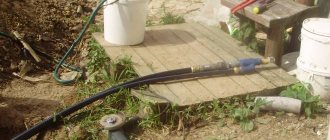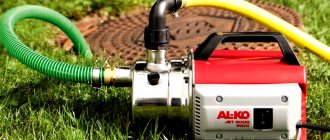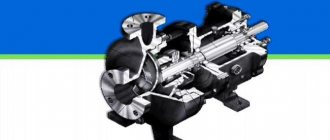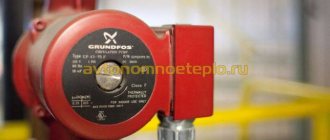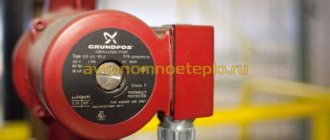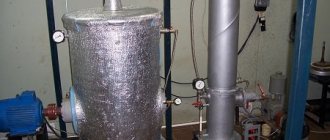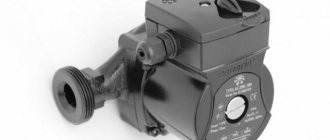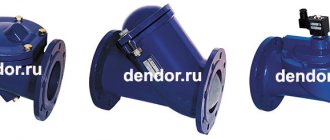Injection pump for water
In an autonomous water supply system at a dacha, the installation of special equipment for servicing the well is required. An injection pump for water is used at a significant depth of the source.
This type of pump has a number of differences from the ejector type of device.
Area of use of the device. Injection pumping devices have special characteristics that allow them to be used to provide large volumes of water to a private home.
Water injection pumps: design and application features
To ensure an autonomous water supply for your dacha or country house, it is not enough to simply drill a well; you also need to purchase and install a device that will serve the well. One type of such equipment, used in cases where the drilled well is of considerable depth, is an injection pump (it should not be confused with an ejector).
Centrifugal pump with remote ejector
Areas and advantages of application
Due to their technical characteristics, injection pumps are successfully used to provide country houses and cottages with sufficient quantities of water. Using such equipment, it is possible to pump water from the following sources with high productivity:
- deep underground wells;
- wells;
- open reservoirs of various types;
- storage tanks and containers.
Pumps of this type have two fittings for connecting an external ejector and another one for supplying water to the consumer
For domestic purposes, ejector pumps can also be used, but many owners of dachas and country houses prefer injection-type pumping equipment. The main reason for this choice is that, while having high performance, such devices consume a minimal amount of electricity during operation.
If we talk about the advantages that distinguish injection-type pumps, then the following should be highlighted among them.
- You can perform the installation yourself without involving third-party specialists.
- Pumps of this type are safe to use.
- The technical capabilities of injection pumps allow them to be successfully used for lifting water from great depths, which submersible models of pumping equipment cannot boast of.
- Thanks to its versatility, the pumping station can be used to solve various problems related to pumping water.
- The high performance of such equipment is combined with minimal energy consumption.
Before being placed in the well, the ejector is assembled and connected to the pipelines
Using injection-type pumps, water can be lifted from a depth of up to 25 m. That is why such equipment is successfully used to supply water not only from wells and open reservoirs, but also from underground wells. More powerful injection pumping stations can be used to lift water from even greater depths.
Water supply station with ejector
Device. Operating principle
An ejector is essentially a device that transfers energy from one more mobile medium to another, which is less mobile. In the tapering sections of the unit, a special zone of lower pressure is formed, which thus provokes the suction of additional medium. Thus, it is possible to move and move away from suction points, due to the interaction of the original environment.
Units equipped with an internal format ejector are intended directly for specialized pumping of liquids from relatively shallow wells, the depth of which does not exceed eight meters, as well as various specialized storage tanks or reservoirs.
The immediate distinctive feature of this interaction is precisely the capture of liquid, which is located at a lower level from the pipe. Based on this, preliminary filling of the unit with water will be required. The working wheel will pump liquid, which will redirect it to the ejector, resulting in the formation of an ejection jet.
It will move through a specialized tube and accelerate. Naturally, the pressure will decrease. Thanks to this effect, it will also decrease inside the suction chamber.
One of the varieties of such surface installation units is a pumping station with an ejector. They differ in that the external element is immersed in the water supply source. As a rule, the scope of application of such devices is similar to their analogues. The definite difference lies in the different depths of use and application.
Design Features
Like any other type of pump, injection models have two main parts: the pump part itself and the electric motor that drives it.
General view of an automatic ejector-type pumping station
Let us list the main design features of injection equipment that distinguish it from other types of units.
- Almost every model has a check valve, which is designed to prevent water from flowing back through the device when it is turned off.
- A special float switch turns off the electric motor in cases where the water level in a well or other hydraulic structure drops. The presence of such a switch protects the pump from running dry, which can lead to its failure.
- The electric motor with which the injection-type pump is equipped is not immersed in water, but is installed in a dry place - on the shore of a reservoir, next to a well or well. In this case, only that part of the pump that is responsible for the rarefaction of air is in the water.
- In the design of injection-type pumps, there is not one discharge pipe, but two suction pipes of different diameters, at the end of each of which a special device is installed - an injector. It is thanks to the presence of such injectors that pumps of this type are capable of pumping water from wells of considerable depth.
- In order for injection-type pumping stations to function normally during the cold season, they are placed in insulated pits or in special caissons.
Installation diagram of the ejector pump
When choosing a place to install an engine that will drive an injection-type pump, two main parameters should be taken into account:
- the depth of the well from which water is to be pumped out;
- the distance of the well from the point to which water must be supplied.
Since lifting water from a well in a vertical direction requires more energy than moving it horizontally, they try to locate the drive motor of the injection pump closer to the well in order to make maximum use of its power.
Pumping station with remote ejector
Manufacturing
It is quite possible to produce a fairly simple device-unit independently. This will require some parts, such as a tee of a specialized diameter and a fitting that will be located inside it. The correct length ratio must be observed, which should not be more or less, which will not allow such a device to function normally. For fastening you will need a special adapter equipped with corners, which will allow you to create the desired rotation.
The creation process involves several specific points, which includes the process of preparing the required fitting itself. Part of a special 6-sided sample should be ground, which will allow it to be made into a special cone, having a base smaller than the external thread in diameter. After which the deformed part should be corrected with a specialized thread-cutting tool.
The fitting must be screwed all the way into the tee piece. When connecting, be very careful about the length ratio, which is a fairly important factor. Be sure to seal the connection with any available sealant.
Check the ratio of the parts being manufactured, and then from pre-prepared samples you should organize a specialized adapter, which is designed for installation on the pipe.
A well-assembled station will ensure fairly long and trouble-free operation due to its simple design, but, naturally, you must be extremely precise in manufacturing. If you don’t really want to engage in such production, then you can simply purchase it in specialized stores, where a pumping station is always available for free sale.
Differences from ejector pumps
To pump water from wells of considerable depth, as mentioned above, you can also use ejector-type pumps, which differ from injection pumps both in their design and operating principle. The main elements of such pumps are:
- chamber for suction of the pumped medium;
- suction pipe equipped with a narrow nozzle;
- diffuser and mixer.
Suction devices and electric motors of ejector pumps can be installed both inside and outside the water supply source. The principle of operation of an ejector pump, which distinguishes it from injection-type pumping equipment, is that the kinetic energy from a flow of water moving at a higher speed is transferred to a flow with a lower speed.
Connection
In the case of a built-in ejector, installation of equipment is not difficult: it is enough to connect the pipeline from the well to the suction inlet, check the hydraulic accumulator and the operation of the automation, which is responsible for autonomous control of the entire system.
With an ejector outside the station, additional installation steps are added:
- we lay a recirculation line from the pressure station, and connect the main pipe from the ejector to the suction pipe of the pump;
- We must connect a check valve to the ejector suction so that the liquid does not flow out by gravity when the pump stops, as well as a filter element so that only clean water continues to flow.
As mentioned earlier, a valve can be inserted into the recirculation line for adjustment, and some designs already have such a device; its placement and adjustment methods are indicated in the operating instructions.
Commissioning works
How long and efficiently an injection-type pump will work directly depends on its adjustment. It must be performed in the following sequence.
- After connecting the injection pump, you need to start it and use a pressure gauge to compare the pressure level when the device is turned off and on. If the difference between the measured values does not fall within the range of 1–1.4 bar, the pump must be adjusted.
- If an injection-type pump needs to be adjusted, it should be turned off by removing the protective cover located in its upper part, above the pressure switch. Adjustment of the pump after removing such a cover is carried out using a screw marked “P”, which should be turned in the direction of increasing or decreasing the pressure, which depends on the results of the measurements taken.
- After the initial adjustment has been completed, the pump should be restarted. When restarting, it is necessary to once again measure the pressure created by the pump in operating condition and calculate the difference between the value of such pressure and the pressure in the working chamber of the pump in its off state. If the calculated pressure difference is within the above value, then the adjustment is correct, otherwise the above procedure should be repeated again.
- The results of the adjustment, if carried out correctly, should be compared with the device’s passport data and the obtained data should be entered into a special journal.
- After completing all the procedures for adjusting the injection pump, its protective cover is put in place and secured with screws.
There are two springs located under the pressure switch cover. The large one is responsible for turning on the pump, and the small one is responsible for the difference between the on and off pressure
Thus, installing and adjusting injection-type pumps does not pose any particular problems, and anyone can perform such procedures without involving qualified specialists, whose services are quite expensive. In addition, servicing such devices is also not particularly difficult, since the main mechanisms are located not in the well itself, but outside it, on the surface of the earth.
The simplicity of the design of injection-type pumps ensures not only ease of maintenance, but also exceptional reliability. The feasibility of using pumps of this type is also evidenced by the fact that such devices are exceptionally versatile.
Source of the article: https://met-all.org/nasosy/inzhektornyj-nasos-dlya-vody-printsip-raboty.html
Using a homemade external option
A built-in ejector is usually purchased at the same time as a pump, but the external model is often made by hand.
It will be useful to consider the creation process and the procedure for connecting such a device. In order to make an ejector, you will need such parts as a tee with internal threaded connections, fittings, fittings, bends, couplings, etc.
Sources
- https://met-all.org/nasosy/ezhektor-chto-eto-takoe-printsip-raboty-ustrojstvo-ezhektornyj-nasos.html
- https://sovet-ingenera.com/vodosnab/nasosy/ezhektor-dlya-nasosnoj-stancii.html
- https://nasosovnet.ru/centr/ezhektornyj-nasos.html
- https://sandizain.ru/na-dache/nasosy/nasos-bytovoj-s-vstroennym-i-vynosnym-ezhektorom.html
- https://VodaSovet.ru/nasos/ezhektor-dlya-nasosnoj-stantsii
What is the difference between an injector and an ejector?
Injector and ejector are types of jet pump. The differences between them lie in the features of their work.
A hydraulic jet pump is a device based on the principle of exchange of mechanical energy between high and low pressure flows. Compatible with liquid, gaseous and bulk substances. If the pump pumps or sprays something, then it is an injector. If the device pumps out something, then it is an ejector.
The design of the hydraulic unit is simple. In its most lightweight form, it consists of two bonded tubes; there are no moving parts or electrical equipment. This simplifies maintenance and increases reliability.
Ejector device
An ejector is a device that transfers the kinetic energy of a medium at a higher speed to a medium at a lower speed when they are connected. Together with a vacuum pump, the device increases the pressure of the sucked liquid. It is often used as a mixer at chemical and oil refineries.
The operation of the ejector pump is based on Bernoulli's principle. To simplify, it can be formulated as follows: the pressure of the flow with a lower speed is higher, and with a high speed, on the contrary, it is lower. That is, a high-pressure flow in a pipe causes suction of a low-pressure flow in a pipe.
The ejector device consists of the following elements:
- pipes with a tapering nozzle into which the ejecting substance enters;
- a branch pipe into which the ejected liquid/gas is sucked in;
- chambers where they mix;
- narrow cylindrical neck;
- wider diffuser;
- outlet tube connecting to the main pipeline.
The remote ejector operates according to the following scheme.
- The working flow is sucked into the main pipe with a nozzle.
- The pressure in the pipe drops sharply. As soon as the speed of movement of the passive medium reaches a certain point, a vacuum is formed in the chamber. That is, the pressure becomes below atmospheric. This leads to liquid/vapor being sucked out of the nozzle.
- The ejected and ejecting media meet in a chamber where they exchange kinetic energy. When entering the diffuser, it is converted into potential compression energy. Under its action, the substance enters the outlet tube.
Operating principle of the injector
The purpose of the injector is to compress gases, vapors, liquids, and pump (spray) them into other units. The device is a standard linear accelerator that injects charged particles into the central components of the machine. Note that the water pressure in the injection unit may be higher than in the ejector unit. The physical states of the substances used are:
- equal phase (gas-gas, steam-steam, liquid-liquid);
- different phases (gas-liquid, liquid-gas);
- changing phase (vapor-liquid, liquid-vapor).
Accordingly, the injector is used as part of various equipment. It is used in the mining industry, power plants, and mechanical engineering; as an integral part of boiler equipment - in the oil and gas industry, housing and communal services, and industrial enterprises.
As an example, let us consider the features of the operation of a steam boiler injector. It is based on its ability to create higher pressure than working steam. The kinetic energy of the latter is converted into water pressure, which enters the boiler. At its core, the injection circuit differs from the ejector circuit only in the presence of a needle valve with a handle. It is designed to regulate the flow and supply of liquid and vapor substances.
- Steam is supplied, which condenses on the cooled walls.
- Due to the pressure difference, water from the reservoir rises into the injection cavity.
- The steam expands and pulls the water flow further into the mixing chamber.
- The composition of condensed steam and water rushes forward along an expanding cone. There, its speed turns into pressure.
- This helps it overcome the resistance of the valve (outlet tube), passing through which it enters the boiler.
The design of the injector (nozzle) in automobile engines is more complex and includes moving elements.
What is the difference
Thus, an ejector and an injector are subtypes of a jet pump. They are distinguished by:
- Operating principle. The ejector pumps out gas/steam/liquid, and the injector, on the contrary, sprays.
- Design. An injection system can be more complicated than an ejector system, although they are basically identical.
- Scope of application. The ejector is used in conjunction with a vacuum pump, the injector - with boiler equipment, automobile engines, etc.
Source of the article: https://npm74.ru/blog/chem-otlichaetsya-inzhektor-ot-ezhektora/
How does an ejector work?
The principle of operation of the ejector is based on the movement of water in the pipe, which, when entering the smoothly tapering part of the ejector, increases its speed, as a result of which a zone with reduced pressure is formed, into which water is sucked in from the outside. The remote ejector of the pumping station operates by supplying water through a recirculation pipeline; the flow, entering the tapering part, increases speed, forming a zone with reduced pressure, where water from the outside begins to be sucked in to compensate for the low pressure. In other words, the ejector pushes water to a height from which the pump can independently suck it up.
The efficiency of the ejector is characterized by the ejection coefficient, which shows the amount of sucked water per unit amount of recirculated water. In our case, the water ejection coefficient is 0.12, that is, with a water flow rate in the ejector of 1000 l/hour, the ejector will suck in about 120 l/hour.
Water booster pump and injection pumps
Water pressure booster pump
Pumps to increase pressure are used:
- in cottage buildings to ensure the functionality of the autonomous heating system;
- at the dacha to supply water to irrigation systems and for summer showers;
- in housing and communal services to ensure uninterrupted water supply to the upper floors;
- in the industrial sector, to provide circulating water for production cycles;
- in the agricultural sector, in irrigation systems.
It is worth noting that on a production scale they rarely use single pumps to increase pressure, but use a unit such as a pumping station, which is a combination of a pair or more pumps.
What types and types of pumps are there? Pumps for increasing water pressure are divided into two types:
It is better to use a pump that has several impellers, since such a pump maximizes the water pressure, since the pressure is increased by each impeller, and the power indicators in the electric motor remain relatively small.
Pumps that increase water pressure also include devices related to pump water pumps and high-pressure submersible pumps, which are used to pump water from great depths.
Pumping station, which is better?
You have decided that you simply need a pumping station. Which is better, a list of popular models, their characteristics, scope of application, consumer opinion - all this undoubtedly interests you. Well, let's take a closer look at pumping stations.
When choosing pumping stations, you should pay attention to the following important characteristics:
- retraction depth. This parameter will determine the maximum depth from which the station can raise water. There is one important point: only the distance between the pump and the surface of the water is taken into account. What is below the surface of the water is not taken into account;
- lifting height. This parameter determines the height to which the pumping station is capable of supplying water. The higher the value of this parameter, the greater the pressure readings taken at the outlet of the pumping station. For example, if this parameter is 46 m, then the station will create a pressure of 4.6 atm. for ideal conditions, but taking into account all kinds of losses, this parameter decreases noticeably.
- productivity (m3/hour). Most often, we are talking about maximum productivity, that is, the one that is developed by the pumping station if the retraction depth and pressure are equal to zero.
Separation of pumping stations depending on pump type
self-priming pumping station. Such a station lifts water from a 9-meter distance, and stations of this type can work even if there are air bubbles in the pipe. The disadvantage of such devices is their noisy operation, for this reason the room in which they are installed is better soundproofed;
- multi-stage pumping station. A pumping station of this type is more productive and less noisy than the previous one. The retraction depth of such stations is 8-9 m. These devices are more expensive due to their more complex design;
- vortex pumping station. They lift water from a 7-m depth, have the highest pressure, but the lowest productivity among all stations with the same power.
Ejector design option 1
The simplest ejector can be assembled based on a tee and fitting - these parts will perform the function of a Venturi tube in a very simplified version. Shaped elements for the ejector can be used from various materials (metal, plastic). In this case, the ejector structure is assembled from a brass tee and collet fittings for metal-plastic pipes.
The diameter of the shaped elements for the ejector design is taken depending on the performance of the pumping station and the diameter of the suction and recirculation pipeline; the diameter of the suction pipeline cannot be less than 25 mm. In our design, a tee with a diameter of 20 mm will be used with a 26 mm suction pipeline and a 12.5 mm recirculation pipeline connected to it.
- Tee ½" mm.
- Fitting ½" mm and with a 12 mm outlet.
- Adapter 20×25 mm.
- Angle 90º (external/internal) for metal-plastic pipe ½"×16 mm.
- Angle 90º (external/internal) for metal-plastic pipe ¾"×26 mm.
- Angle 90º (external/internal) ¾"×½".
The lower base of the resulting cone should have a diameter several millimeters smaller than the outer diameter of the fitting thread, and its thread should also be shortened so that a maximum of four turns remain. Using a die, you need to drive the thread and cut a few more turns on the resulting cone.
Now you can assemble the ejector. To do this, we screw the fitting (2) with its narrow part inside the tee (1) so that the fitting extends 1–2 mm beyond the upper edge of the side outlet of the tee, and so that at least four turns remain on the internal thread of the tee so that the outlet can be screwed in (6). If the remaining free thread of the tee is not enough, you will need to grind off the threads of the fitting; if the length of the fitting is not enough, you can put a piece of tube on it. A check valve must be connected to the outlet (5) through which water will be suctioned, so that when the system starts, water does not flow out of the suction and recirculation water supply, otherwise the system will not start. You also need to seal all threaded connections using any sealant.
Such an ejector will not have a high ejection coefficient due to the imperfect design of the Venturi tube, so it can be used to lift water from a depth of no more than 10 m.
Jet pump: design, principle of operation, calculation
Jet pumps are the simplest in principle of operation and design among pressure equipment. Such a unit is dynamic, that is, it does not contain moving parts. This is a plus of such a device, since it prevents wear and tear.
The first jet pump was used at the end of the 19th century as a tool for sucking air and water from test tubes. Then they began to use it to pump water out of mines. In the USSR, such pumps began to be widely used only in the middle of the last century.
Principle of operation
The design of the jet pump is quite simple and requires virtually no maintenance. When the pump is running, water, steam or gas moves through a pipe with a converging nozzle. Thanks to this nozzle design, the speed of the moving mass increases.
Inside the supply chamber, the water pressure decreases and becomes below atmospheric pressure, as a result of which a vacuum is created in the chamber.
Suction occurs from a pipeline connected to the chamber. During operation, the working fluid is mixed with the pumped liquid. Then this mass enters the diffuser, and then into the reservoir.
Thus, the jet pump operates using the pumping principle.
Varieties
Depending on the type of pumped and working fluid, there are three types of jet pumps. These include:
- Ejector. This type of jet pump is used only for pumping liquid. The mechanism of operation is to suction liquid substances. The working fluid is water.
- Injector. It works on the principle of pumping liquid substances. The working substance is steam.
- Elevator. Used to lower the coolant temperature by mixing with the working fluid.
In general, jet pumps can pump liquid, gas and steam. They can be used as liquid-jet units (for mixing and transporting working and passive fluid with a pressure difference) and air-lift/air-lift units (performs the function of lifting liquids).
If the pump is used only for pumping water, it is called water jet. It can have two modifications: a vacuum pump (working for use in laboratories) and a hydraulic elevator (used for wells with a depth of up to 16 meters).
Areas of use
Jet pumps are widely used in various industries. Moreover, they can be used as independent units or together with other pumping units.
Due to their simplicity of design and high reliability, such units are indispensable when working at reactors, in emergency situations with water outages, and during fire fighting.
Such designs are often used in applications where vane pumps cannot operate effectively (for example, when pumping chemically aggressive substances), or in a system with vane pumps to improve their efficiency.
In addition, these pumps are used in air conditioning systems, sewage systems, for drainage and dewatering. One of the most important indicators for this technique is the suction coefficient. This value is the ratio of the flow rate of the working fluid and the pumped substance.
Despite the simplicity of the design and low efficiency, this type of mechanism is often used in cases where it is impossible to use any other type of pump. They are easily installed in the pipeline system. Often available with a variable nozzle.
Features of jet pumps:
- high reliability;
- no need for regular maintenance;
- wide scope of application;
- simple design.
- low level of efficiency (no more than 30%).
Model for cement
This technique is widely used for transporting cement. When exposed to compressed air, bulk materials are transported from bins to vehicles for transportation.
The mechanism of action here is as follows: under high air pressure, cement particles crumble so much that they become volatile. As a result, air currents can move them in a given direction.
It should be noted that the process of pumping cement in this way takes place under high pressure, so the supply distance of this material is limited in space. For example, the maximum distance to which the mechanism supplies cement along the vertical axis is no more than 50 meters. Along the horizontal axis, this distance cannot exceed 400 meters.
To transport cement, as well as other bulk materials, a CH 2 jet pump with an intensifying chamber can be used. Compressed air is used to move masses through pipelines.
Technical characteristics of CH 2:
- productivity: 25 t/h;
- weight – 200 kg.
- rise in height: 25m;
- horizontal feed length: 150m;
- compressed air pressure: 0.2-0.3 MPa;
- compressed air consumption: 3 m³/min.
Household models
These units, especially those used in everyday life, have low production characteristics. A pump installed in a home well pumps only 15-17 liters per second. A more professional (and therefore expensive) device can pump 30-50 liters per second.
The height of water lift with a household jet pump varies within 15 meters. Some devices can lift liquid 20 meters, but the efficiency will decrease accordingly. More powerful and professional equipment can lift water from a depth of 50 m.
For the oil industry
A jet pump for oil production consists of the following parts: a channel for supplying working fluid, an active nozzle, a channel for supplying injected fluid, a displacement chamber and a diffuser.
Choice: built-in or external?
Depending on the installation location, there are remote and built-in ejectors. There is no big difference in the design features of these devices, but the location of the ejector still affects in some way both the installation of the pumping station and its operation.
So, built-in ejectors are usually placed inside the pump housing or in close proximity to it. As a result, the ejector takes up minimal space and does not have to be installed separately; it is enough to carry out the usual installation of the pumping station or the pump itself.
In addition, the ejector located in the housing is reliably protected from contamination. Vacuum and reverse water intake are carried out directly in the pump housing. There is no need to install additional filters to protect the ejector from clogging with sludge particles or sand.
A remote ejector for a pumping station is more difficult to install than an internal model, but this option creates a much less noise effect
However, it should be remembered that this model demonstrates maximum efficiency at shallow depths, up to 10 meters. Pumps with a built-in ejector are designed for such relatively shallow sources; their advantage is that they provide excellent incoming water pressure.
As a result, these characteristics are sufficient to use water not only for domestic needs, but also for irrigation or other economic operations. Another problem is the increased noise level, since the vibration of the operating pump is added to the sound effect of water passing through the ejector.
If you decide to install a pump with a built-in ejector, you will have to take special care of sound insulation. It is recommended to install pumps or pumping stations with a built-in ejector outside the house, for example, in a separate building or in a well caisson.
The electric motor for a pump with an ejector must be more powerful than for a similar model without an ejector.
An external or external ejector is installed at a certain distance from the pump, and this distance can be quite significant: 20-40 meters, some experts even consider 50 meters acceptable. Thus, a remote ejector can be placed directly in a water source, for example, in a well.
The external ejector does not so much increase the pump’s performance as it is designed to increase the depth of water intake from the source, which can reach 20-45 m
Of course, the noise from the operation of an ejector installed deep underground will no longer disturb the residents of the house. However, this type of device must be connected to the system using a recirculation pipe through which the water will return to the ejector.
The greater the installation depth of the device, the longer the pipe will have to be lowered into the well or well.
It is better to provide for the presence of another pipe in the well at the design stage of the device. Connecting a remote ejector also involves installing a separate storage tank from which water will be drawn for recirculation.
Such a tank allows you to reduce the load on the surface pump, saving some energy. It is worth noting that the operating efficiency of the external ejector is somewhat lower than that of models built into the pump, however, the ability to significantly increase the intake depth makes one come to terms with this drawback.
When using an external ejector, there is no need to place the pumping station directly near the water source. It can be installed in the basement of a residential building. The distance to the source can vary within 20-40 meters; this will not affect the performance of the pumping equipment.
Water injection pump and unit design
If your country house or dacha is located far from centralized water supply systems, and you want to provide yourself with the benefits of civilization, then to get to water, you can build a well or borehole on your property.
From this hydraulic structure, you can lay a pipeline to the house and, using pumping equipment, supply water directly to the house. However, if your well or well is shallow, then you can use a regular submersible pump, but to pump out liquid from a deep water intake you will need a special pumping device called an injection pump.
This device should not be confused with its ejector counterpart, because they have significant differences. In our article we will look at the purpose, operating principle and advantages of an injection pump.
Features and purpose
A pumping device with an injector is a special type of pump that is designed to provide autonomous water supply to a country house or cottage. The pump is suitable for lifting water from great depths from various types of hydraulic structures (wells, wells), various open reservoirs, storage tanks and various reservoirs.
An injection or ejector pump can be installed in the pumping station. We will look at the main differences between them below. For domestic needs, injection pump devices are more suitable. The thing is that with excellent performance they consume a minimum of electricity.
Among the advantages of these units it is worth listing the following:
- Simplicity and accessibility of installation. You can install the unit yourself without the help of specialists.
- Such equipment is completely safe.
- These units can lift water from significant depths where traditional submersible pumps cannot cope.
- The device can be used to solve household problems and pump water for the water supply of a private home.
- The injection unit has high performance.
- Reduced energy consumption reduces operating costs.
Injection pumps are designed to lift water from significant depths. This unit can pump water from a depth of 25 m. That is why they can be used to lift liquid not only from wells and open reservoirs, but also from wells. If you want to pump water from wells more than 25 m deep, you can choose more powerful injection pumping stations.
Design
As a rule, a pump injection device consists, like a traditional pump, of a pump part and an electric motor in a special chamber. However, there are some differences in the design of such a unit:
- Almost every injection pump device is equipped with a check valve that protects the equipment from spontaneous backflow of water after the pump is turned off.
- If the water level drops in a well or other hydraulic structure, the automatic float switch will turn off the unit, thereby protecting it from running dry. In the absence of such protection, the electric motor of the device can quickly fail.
- The injection pump motor itself is installed on the surface near a reservoir, well or well, and a mechanism responsible for rarefaction of air is immersed in the water.
- The injection unit is equipped with two suction pipes. One of them has an increased diameter, the second is narrower. At the end of each pipe there is a special nozzle - an injector. Thanks to this nozzle, the unit can lift groundwater from a considerable depth.
Tip: when choosing a place where the engine will be located, it is worth considering not only the lifting depth, but also the distance over which the liquid needs to be pumped. It is usually recommended to locate the unit closer to the water intake, since the power consumption for vertical lifting of liquid is higher than for its horizontal transportation.
To ensure operation in winter, the injection pumping station is installed in a special caisson or insulated pit.
Differences from ejector-type units
Another type of self-priming pump for pumping water is an ejector-type unit. This device also allows you to pump water from great depths, but has a different structure than an injection-type pump.
It consists of the following components:
- suction chamber;
- special nozzle - a pipe with a narrow end;
- diffuser and mixer.
In this case, the ejector can be installed internally or externally. The differences between injection and ejector units also lie in the principle of operation. Essentially, the ejector transfers the kinetic energy of water at a higher speed to a medium at a lower speed.
Commissioning works
The uninterrupted operation and durability of injection pumping equipment depends on the correct adjustment of its operation upon first start-up. Typically the adjustment process includes several steps:
- After connecting the device, start it. Using the built-in pressure gauge, evaluate the pressure when the unit is turned on and off. Write down the results. If the difference between this value does not fall within the limit of 1-1.4 bar, you need to adjust the device.
- To do this, turn off the pump. Open the protective cover on the top of the device above the pressure switch (just turn the fastening device). There you will see two screws. Pressure adjustment is carried out with a screw marked P. It should be turned towards increase or decrease depending on the resulting pressure difference.
- After the initial adjustment, restart the unit. Also measure and find out the pressure difference. If it falls within the limit described above, the adjustment has been performed correctly. Otherwise, repeat step 2.
- The set parameters must be compared with those indicated in the product passport. The data is entered into a log.
- After completing the adjustment, the protective cover is put in place and secured with a fastening screw.
Source of the article: https://aomur.ru/prochee/kakie-osobennosti-inzhektornogo-nasosa.html
How to extend the life of the ejector
To extend their service life, pumping stations with an ejector must be operated in compliance with the following rules:
When installing a station, it is important to correctly calculate the ratio of the power of the device and the depth of the source from which water is extracted. Constantly monitor the pressure in the pipeline
To measure the pressure in the system, you can use a pressure gauge used for car tires or purchase a station with a special built-in sensor; for sources with great depth, it is necessary to purchase a powerful pump, which must be installed as close as possible to the water intake; the use of a built-in ejector is justified only at high-power stations; when the source depth is from 15 to 40 meters, it is necessary to use a remote ejector installed inside the well and located in the water. When using a surface-type pump, it is important to correctly install the pipes coming from the surface of the ejector - strictly vertically. If the pipes are positioned incorrectly, air will enter the system and air pockets will form, which will negatively affect the operation of the system and reduce its service life.
If all operating rules are followed, ejector pumping stations operate uninterruptedly and provide tap water to the home, irrigation and other equally important household needs.

